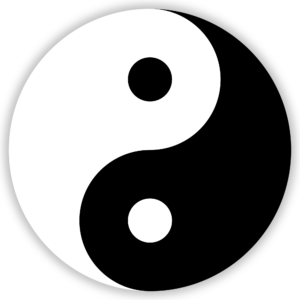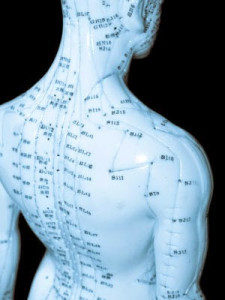What is Acupuncture and How does it work?
 Acupuncture is a method of sending a signal to the body ( by needle or other means ) to “turn on” its own healing or regulatory mechanisms. Acupuncture restores the homeostatic balance by a differential effect in suppressing hyper function, stimulating hypofunction, and regulating disturbed function.
Acupuncture is a method of sending a signal to the body ( by needle or other means ) to “turn on” its own healing or regulatory mechanisms. Acupuncture restores the homeostatic balance by a differential effect in suppressing hyper function, stimulating hypofunction, and regulating disturbed function.
There are energy channels, called meridians which are like rivers flowing through the body to irrigate and nourish the tissues. If there is any obstruction to the flow the energy backs up the flow in one part of the body which can cause pain and discomfort or the patient may feel a sensation of not feeling well at certain time of the day. When ones the block can be overcome by placing the acupuncture needle in the correct location the needles can unblock the obstruction and reestablish the regular flow through the meridians. By doing so the treatments can help the body’s internal organs to correct the imbalances in their digestion, absorption, and energy production activities, and in the circulation of their energy through the meridians.
The modern explanation is acupuncture points stimulates the nervous system to release chemicals like endorphin and other hormones like cortisol which influence the body’s own internal regulating systems. The improved energy and biochemical balance produced by acupuncture results in stimulating the body’s natural healing abilities, and in promoting physical and emotional well-being.
History
Acupuncture was practiced by Chinese for more than 2000 years and in ancient  times the superior physicians used acupuncture to prevent disease from occurring and also treated patients who suffered from diseases. Medical acupuncture is a term used to describe acupuncture performed by a qualified doctor who is well trained and licensed in Western medicine who has also had thorough training in acupuncture as a specialty practice. Such a doctor can use one or other approach as the need arises to treat an illness.
times the superior physicians used acupuncture to prevent disease from occurring and also treated patients who suffered from diseases. Medical acupuncture is a term used to describe acupuncture performed by a qualified doctor who is well trained and licensed in Western medicine who has also had thorough training in acupuncture as a specialty practice. Such a doctor can use one or other approach as the need arises to treat an illness.
Medical Acupuncture is often associated with pain control but in the hands of a well-trained and well qualified practitioner it has much broader application and can be used to promote health and wellbeing, prevention of illness and treatment of various medical conditions.
What is Auriculotherapy?
Auricular Acupuncture is used in the diagnosis and management of various medical conditions and unless there is any pathology in the body the ear acupuncture points does not show up. Auriculotherapy is the therapeutic intervention in which stimulation of the auricle of the external ear is utilized to alleviate health conditions in other parts of the body. While originally based upon the ancient Chinese practice of acupuncture, the somatotopic correspondence of specific parts of the body to specific parts of the ear was first developed in France.
The practice of Traditional Chinese Medicine (TCM) utilizes ear acupuncture as a supplement to the insertion of needles into body acupuncture points. Some acupuncturists stimulate ear reflex points as the sole method of acupuncture practice, often find it more rapid and more effective than body acupuncture treatments.
Acupuncture and General Medicine
Medical Doctors specializing in Anesthesiology, surgery, internal medicine and family practice have utilized Auriculotherpy for the management of chronic pain, the treatment of acute muscle sprains, and the reduction of unwanted side-effects from narcotic medications and cessation of smoking. Auriculotherapy has been used to alleviate a variety of somatic complaints seen in standard medical practice. Auriculotherapy has been used to achieve dental analgesia for relief of acute pain from dental drilling or teeth cleaning.
How many treatments and what will you feel?
The number of treatments needed differ from person to person. For complex long standing conditions one or two treatments per week for several months may be recommended. For acute problems, usually fewer visits are required, and for health maintenance, four sessions a year may be all that is necessary. Usually there are no side effects. Occasionally, the original symptoms worsens for a few days, or other general changes in appetite, sleep, bowel or urination may be triggered. They are simply indications that the acupuncture is starting to work. It is quite common with the first one or two treatments to have a sensation of deep relaxation or even mild disorientation immediately following the treatment. These pass within a short time.
Patient Experience with Acupuncture
People experience Acupuncture needling differently. Most patients feel only minimal pain as needles are inserted. Some feel no pain at all. The needles are all disposable needles. There is no risk of infection from the treatment. Acupuncture is effective, safe, affordable and acceptable.
Success of Acupuncture
Acupuncture is used successfully on cats, dogs, horses and other animals. These animal patients do not understand or believe in the process that helps them get better. A positive attitude towards wellness may reinforce the effect of the treatment received, just as a negative attitude may hinder the effect of acupuncture or any other treatment.
Patient Preparation – Before and After Acupuncture
Do not eat unusually large amount of meal immediately before or after your treatment. Do not over-exercise or consume alcoholic beverages within six hours before or after treatment. Plan your activities so that after the treatment you can get some rest. Continue to take any prescription medication as directed by your medical doctor. Substance abuse (drugs and alcohol) especially in the week prior to treatment, will seriously interfere with the effectiveness of the acupuncture treatments. Remember to keep good mental or written notes of what your response is to the treatment. This is important for your doctor to know so that the followup treatments can be designed to best help you and your problem.